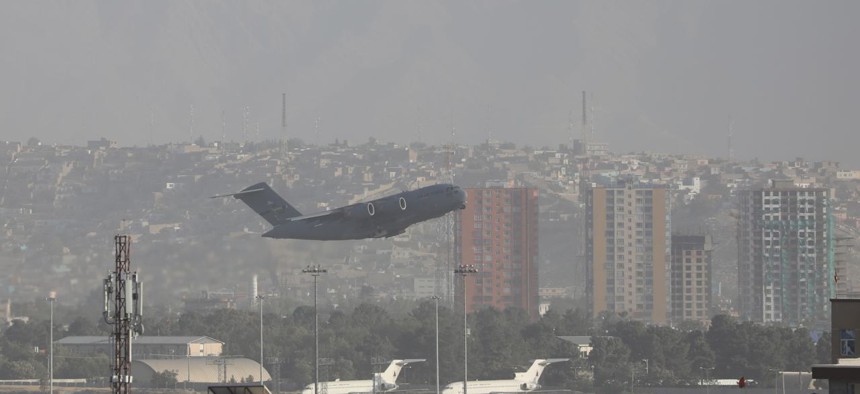
A U.S. plane leaves Kabul airport as evacuations continue, a day after an explosion outside a crowded airport gate in Afghanistan on August 27, 2021. Anadolu Agency via Getty Images / Haroon Sabawoon
U.S. Conducts Airstrike on ISIS-K Planner in Afghanistan
Embassy issues second warning to Americans at Kabul airport gate: ‘Leave immediately.’
The U.S. conducted a targeted drone strike in Afghanistan late Friday in retaliation for a suicide bombing Thursday that left 13 U.S. service members and scores of Afghan civilians dead.
"U.S. military forces conducted an over-the-horizon counterterrorism operation today against an ISIS-K planner. The unmanned airstrike occurred in the Nangahar province of Afghanistan. Initial indications are that we killed the target. We know of no civilian casualties,” Capt. Bill Urban, spokesman for U.S. Central Command, said in a written statement.
The strike comes as U.S. military officials brace for another attack at the airport by ISIS-K. On Friday, Pentagon spokesman John Kirby said the government had “specific” and “credible” intelligence that another attack is forthcoming in the final days of U.S. military presence in Kabul.
As the U.S. military has reduced its presence in Afghanistan, officials have repeatedly said they will be able to continue to target terrorist threats through “over the horizon” capabilities, such as drones, long-range bombers or fighter jets.
Late on Friday, the State Department issued its second dire warning to the estimated 1,000 or so Americans still in Afghanistan: “Because of security threats at the Kabul airport, we continue to advise U.S. citizens to avoid traveling to the airport and to avoid airport gates. U.S. citizens who are at the Abbey gate, East gate, North gate, or the New Ministry of Interior gate now should leave immediately.”
The State Department issued a similar warning just hours before Thursday’s attack, in which an attacker detonated a suicide vest just outside Abbey Gate. Gunfire followed nearby, from what U.S. officials believe were multiple ISIS-K shooters.
U.S. forces have battled elements of ISIS-K for years. In 2017, the U.S. dropped “the mother of all bombs,” or MOAB, on an ISIS-K cave in Nangahar Province, to the east of Kabul along the Pakistan border. Today, the terrorist group is believed to have between 1,500 and 2,200 fighters in Afghanistan, according to a June United Nations report. It is a sworn enemy of the Taliban and seeks not only to target U.S. forces but also to disrupt the Taliban’s assumed takeover of governance of Afghanistan, according to national security analysts.
All U.S. forces are expected to depart Afghanistan by Aug. 31.
Don't miss:




